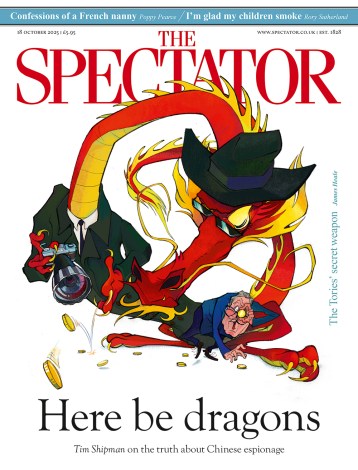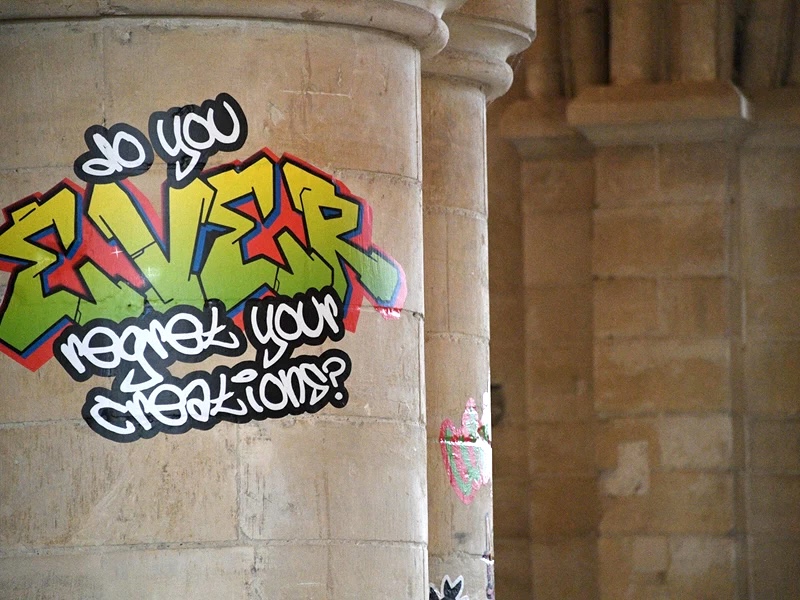There was confusion in Canterbury Cathedral this week as the Dean and Chapter gave permission for this most venerable shrine of world Christendom to be redecorated in the manner of the M4 Chiswick flyover. Photographs appeared of the cathedral’s ancient walls and columns irregularly plastered in jagged and bulbous graffiti, picked out in the sort of gaudy palette you might see in an amusement arcade. Even vice president J.D. Vance has questioned whether this is the right way to treat the house of God, saying the graffiti made a ‘beautiful historical building really ugly’.
It soon transpired that this graffiti spattered over the site of Becket’s martyrdom was in fact a temporary art installation. Created by ‘skilled artists’, according to the cathedral website, the project, named HEAR US, focuses on ‘partnering with marginalised communities – such as Punjabi, black and brown diaspora, neurodivergent, and LGBTQIA+ groups – to collaboratively create handwritten literature responding to the question, “What would you ask God?”’
These questions – for example, ‘Are you there?’, ‘Do you regret your creation?’, ‘Where does love come from?’, ‘Do you want company?’ – have been turned into computer-generated graffiti stickers and ‘expertly and sensitively fixed to the ancient stone pillars, walls and floors of the cathedral’ to ‘offer new interpretations of faith and worship practices, demonstrating that spirituality is not static, but an evolving journey’.
‘Graffiti is the language of the unheard,’ declares the exhibition’s commentary. It is reasonable, we are told, to cover the cathedral in spray-paint-like daubings because ‘Canterbury Cathedral has a great variety of historical graffiti’, including masons’ marks and religious graffiti.
This is not untrue. Go to any medieval church and look closely at the stonework, especially by the porch, doorways, or in the tower. Shine a torch across them and suddenly a host of ancient scratchings will jump out. My own church, St Michael’s Shute in Devon, has a number of inscribed crosses, including a consecration cross dating back to the foundation of the church, perhaps in the 12th century, marking where the bishop had anointed the walls with oil.
You can see a mass-dial – traces of a makeshift sundial used to indicate the times of church services. There are daisy wheels and interlined VVs – the Virgo Virginum (Virgin of Virgins) mark in honour of the Blessed Virgin Mary – which were both often placed near doors and windows to turn away evil spirits. There are hands and several shoes, perhaps the mark of pilgrims or made in thanks for the healing of these body parts. In the inaccessible bell tower, generations of bell-ringers have discreetly etched their names.
Many of these are indeed the marks of the otherwise unheard. But they are expressions of simple piety in an understated form, which was universally accepted over centuries as appropriate for sacred spaces. How can Canterbury Cathedral draw a parallel between these humble incisions and the fat-felt-tipped scrawlings redolent of the Bakerloo Line?
Others have argued that colourful graffiti is appropriate for the cathedral, as before the Reformation it would have been liberally covered in bright paintings. Again, this is not incorrect. But again, the pre-Reformation paintings were in an answerable style to the context. In the first place, church art should be ‘books for the unlettered’, in the seventh-century formulation of Pope Gregory the Great, teaching the illiterate the substance of scripture. Beyond that, in the words of the 12th-century monk and artisan Theophilus, church art should show the beholders ‘something of the likeness of the paradise of God’. The ‘images of the church’, said the 14th-century mystic Walter Hilton, ‘cannot represent to the eyes of onlookers any semblance of divine nature in themselves’. However, by the use of stylised representations of scriptural characters, universally understood symbols – the halos of the saints, the palms of the martyrs – and the insistence on richness and beauty, worshippers could be moved to a sense of heaven in the mind.
It brings to mind not the beauty of holiness, but a urine-sodden Zone 3 underpass
The Canterbury graffiti does none of this. It does not teach. It poses questions which, at best, are the proper province of prayer and debate. It is not beautiful. It is a breach of canon law, which requires pictures in church to be ‘edifying’ and to ‘befit the House of God’. It brings to mind not the beauty of holiness, but a urine-sodden Zone 3 underpass.
Who is this exhibition really for? Not for the thousands of worshippers in the cathedral who will be looking to pray in a place of beauty and sincere devotion. Nor will it draw in the young of the quiet revival, who are weary of contemporary gimmicks and who are looking for the authenticity and rigour of tradition. It rather bears every hallmark of being merely for those who commissioned it: an out-of-touch and self-satisfied stratum in ecclesiastical authority who mistake the hackneyed progressive for spiritual bread; who disdain the sanctity of places where prayer has been valid; who believe that desecration is stewardship, and think that inviting needless offence is a sign of success. And what poverty of expectation to believe that the ‘marginalised’ would prefer graffiti to the native beauty and grandeur of the cathedral.
Is it too much to ask that they would have the humility to respect the holiness that has been entrusted to them, and the confidence to offer it to a world which is crying out for it undefiled?







Comments